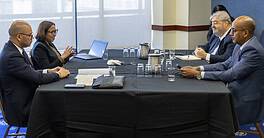Corporate risk planning is driving a deeper embrace of ESG, with banks and their customers collaborating in this rapidly changing sector.

When ING Bank and Dutch electronics giant Philips launched the first sustainability-linked loan in 2017, “banks asked us, ‘What are you doing?’” recalls Robert Spruijt, ING’s head of Sustainable Finance for Europe the Middle East and Africa (EMEA). Unlike a traditional green loan, the €1 billion (about $1.1 billion) revolving credit facility did not have to be used for environmental purposes. Instead, its pricing was tied to Sustainalytics’ sustainability rating for Philips: Better ratings meant cheaper loan terms.
“[Banks] didn’t fully embrace yet that sustainability could be linked to the interest margin of a financial product,” Spruijt adds.
Since that landmark transaction, sustainable debt finance has ballooned, surpassing $1.6 trillion in 2021, more than double its 2020 total, according to BloombergNEF. Some of the fastest growth was in benchmark–or target-linked instruments–like the Philips loan. In 2021, sustainability-linked loans and bonds for financial entities, utilities and consumer discretionary companies topped $530 billion–a 300% surge over 2020.
“It just shows you what throwing a stone into a pond can do,” says Spruijt. “It creates a wave, not just a ripple.”
Henrik Lang, managing director and head of Global Liquidity, Global Transaction Services, at Bank of America (BofA), sees a new mindset taking hold in treasury departments as to how they engage with financial partners. “[Requests for proposals] used to be about capabilities and pricing,” Lang says. “Now, treasurers want to know about our responsible growth and corporate strategy, our Scope 2 and Scope 3 emissions, and how we are going to get to net zero. They’re also asking how we support minority-owned companies.”
In sum, treasury teams are learning how to drive environmental, social and governance (ESG) objectives forward—not only in their financing and investment activities, but via a range of efforts that include moving from paper to digital, incorporating sustainability into governance, building more-inclusive and diverse teams, and including ESG screening when engaging banking and technology partners. BofA’s Lang sees ESG creating differentiation where treasury products have become commoditized: “If banks are charging the same price for a wire, but one bank has more of a focus on ESG, it is easier to justify why a treasurer would go with the bank that has a greater weighting toward ESG.”
Sustainable financing can accelerate a transition to net zero, but not without clear focus on actual impact, according to Arjan de Draaijer, a leader of the CFO Network at the World Business Council for Sustainable Development (WBCSD)—for example, how much CO2 is a particular loan or investment saving? That requires more conversations between CFOs and ESG specialists, he believes.
“Many companies have ESG teams and experts who understand the topics and what stakeholders demand,” de Draaijer says. “But in many cases, these teams still work in silos and have limited communication with the CFO. The ESG specialist really needs to be the right hand of the CFO to properly integrate ESG considerations into financial decision-making.”
Benchmarks, Standards and Regulation
Viktor Ivanov, head of Sustainability for Transaction Banking, EMEA, at BNP Paribas, says some companies now include a set of reporting obligations for the bank on specific ESG key performance indicators over the life of a mandate. Over time, he expects convergence toward a set of criteria that are meaningful for companies and banks alike and that will separate best-in-class from average players.
Regulations around ESG will profoundly impact the development of standards and disclosure. Europe is setting the pace with a raft of measures that include the EU Taxonomy, designed to help determine which economic activities are considered “environmentally sustainable.” The EU’s Corporate Sustainability Reporting Directive requires certain large, listed companies, including banks, to disclose how they manage social and environmental challenges.
If implemented, the European Commission’s proposed Corporate Sustainability Due Diligence Directive will require two groups of larger companies—those with more than 500 employees and global net revenue of more than €150 million, and those in specific high-impact industries with more than 250 employees and global net revenue of more than €40 million—to identify, prevent and mitigate human rights and environmental impacts connected not only with their own operations, but also those of their subsidiaries and value chains. This will include non-EU companies that are active in the EU and meet those thresholds.
“Corporate treasurers will have to contribute to detailed disclosures on sustainability-related issues,” says Ivanov, “which will in turn feed into the reporting requirements of their investors and banks, which are faced with similar disclosure regulations of their own.”
In the US, similar disclosure requirements are emerging. On March 21, the US Securities and Exchange Commission (SEC) proposed several new rules requiring public companies to report climate risks and greenhouse gas emissions. Marina Petroleka, global head of ESG Research in Fitch’s Sustainable Finance Group, says the SEC proposal asks for corporate climate-related disclosures to be conducted in a specific way to ensure transparency and may impose liabilities if companies withhold information.
The IFRS Foundation, parent organization of the International Accounting Standards Board, which administers international accounting standards, has also created the International Sustainability Standards Board, which in turn recently published its first sustainability disclosure standards. Several countries, including Brazil, Hong Kong, Japan, New Zealand, Singapore, Switzerland and the UK have announced requirements for domestic organizations to report climate-related disclosures in alignment with the Task Force on Climate-Related Financial Disclosures, which aims to develop a consistent set of climate-related financial risk disclosures for use by companies, banks and investors.
“Regulators are increasingly pushing [companies] to have a strategy around their ESG disclosure and how they are going to transition to net zero,” explains Spruijt.
However, Wim Bartels, also at WBCSD’s CFO Network, sees confusion arising from many competing standards in this nascent field. “The danger is that CFOs fall into a compliance trap,” he says, “and that the effort required is so high it takes attention away from actions needed to improve sustainability.”
Increasingly, major companies are being asked to take responsibility for ESG consequences from end to end and for the long term. “CFOs also need to start looking at least five years ahead if they are investing in a new asset, to understand how, for example, climate may impact that asset,” Bartels notes.
The EC’s proposed directive on corporate sustainability due diligence will require companies to take direct responsibility out to the far ends of production. “For larger companies with more-sophisticated supply chains, this level of transparency becomes exponentially harder the more you drill down into small and medium-size enterprises,” Petroleka explains. She notes that such smaller companies are the bulk of most economies, but also account for a significant portion of Scope 3 emissions.
Ayeesha Sachedina, chief transformation officer, Global Transaction Services at BofA, says companies need to include training in those lower tiers of their supply chain, where it is harder to measure ESG but where efforts are likely to have the biggest impact. “It is not just about having the right data,” she adds, “but also the right skill sets and understanding of ESG throughout the organization to make decisions.”
BNP’s Ivanov says corporate treasurers can help tackle the imperative of sustainable transition to shorter, more-circular and less carbon-intensive value chains by providing financial incentives to suppliers for meeting ESG goals. Some companies are also building and deploying their own, in-house, supplier-assessment methodologies and audit requirements, he says; or they are resorting to standardized approaches, such as common reporting requirements and mutualized audits agreed at sector level. “Longer term, these developments could have far-reaching implications if the approach is replicated to second-tier suppliers and then deeper into the value chain to create a level of visibility unheard of today,” Ivanov says.
Specialized providers of supplier evaluations and ratings, such as EcoVadis or CDP’s supply chain disclosure system, bring benefits in terms of transparency, objectivity and scalability.
However, Bartels says working with sustainability data and supply chain emissions is completely different from working with financial data that is accurate and precise. “You can lose yourself in trying to get a precise understanding. … This is new territory for CFOs.”



